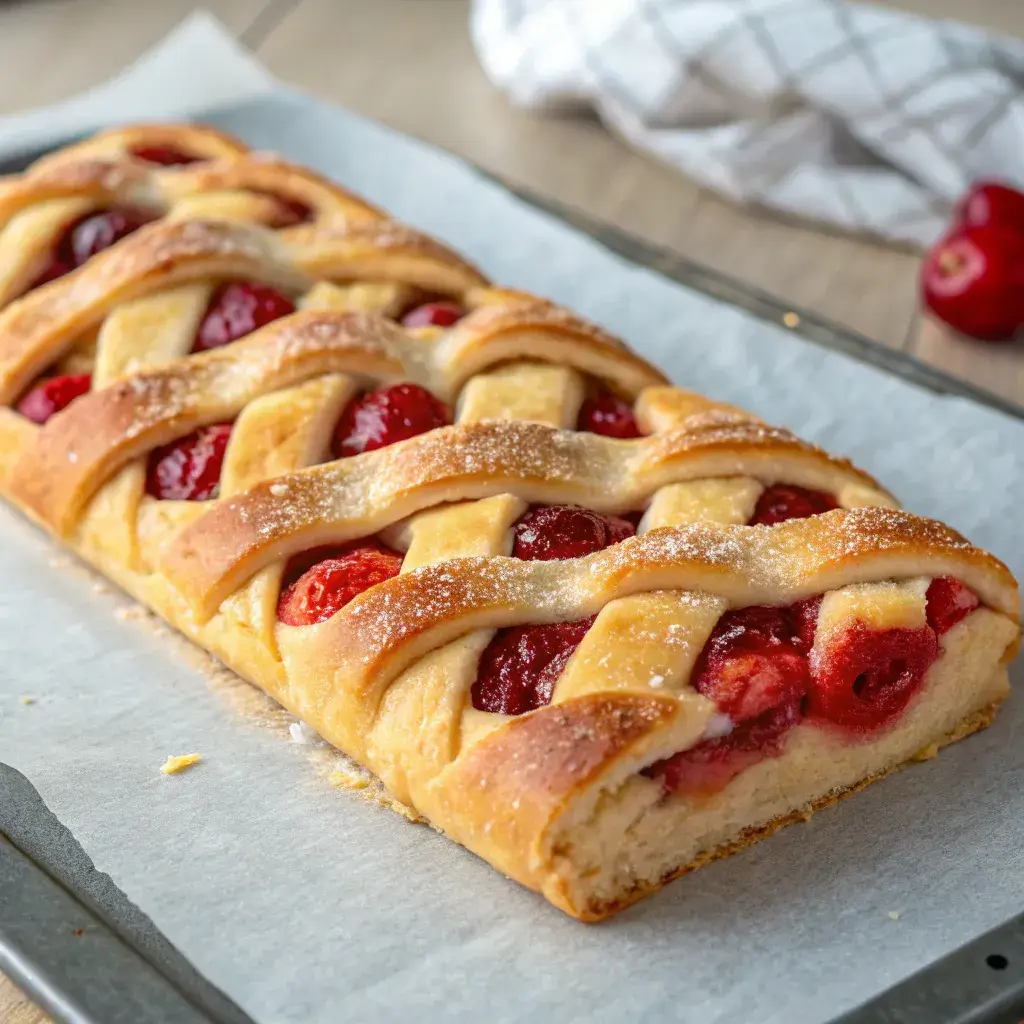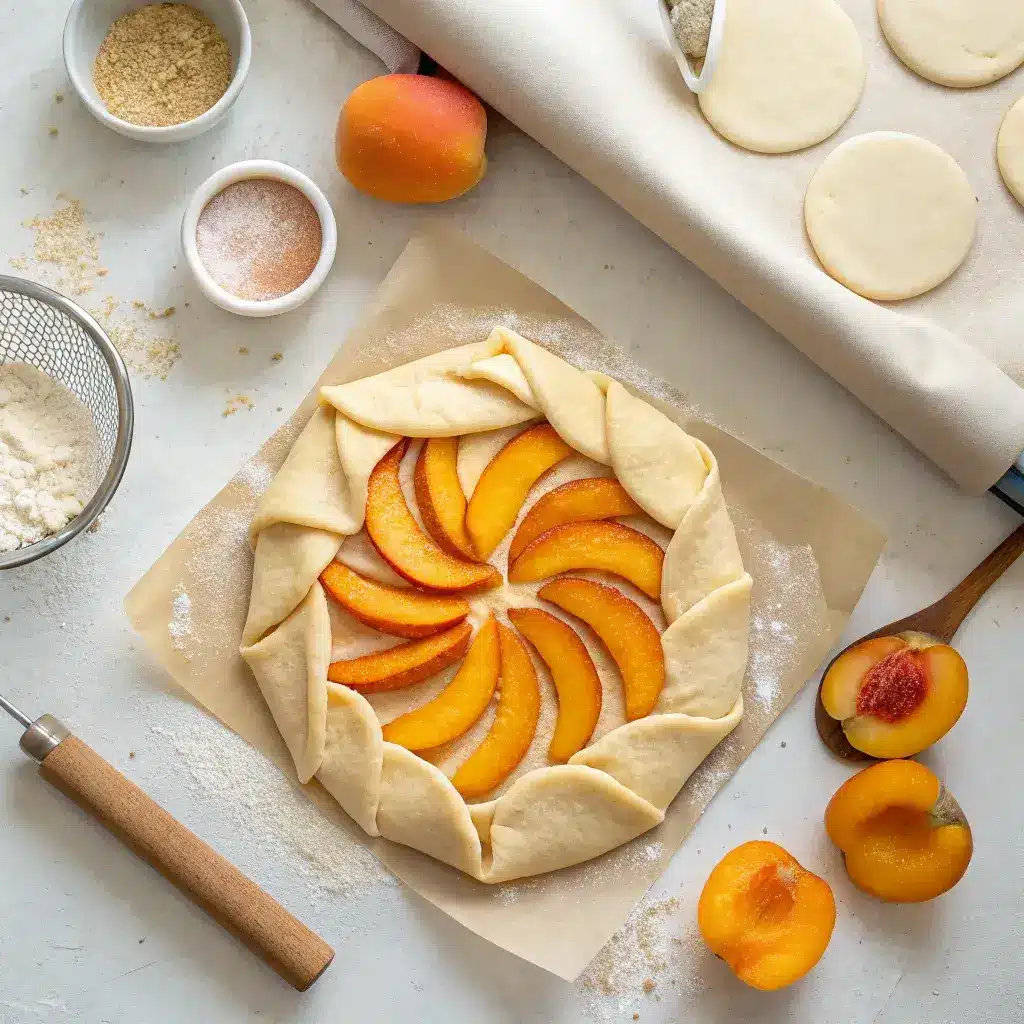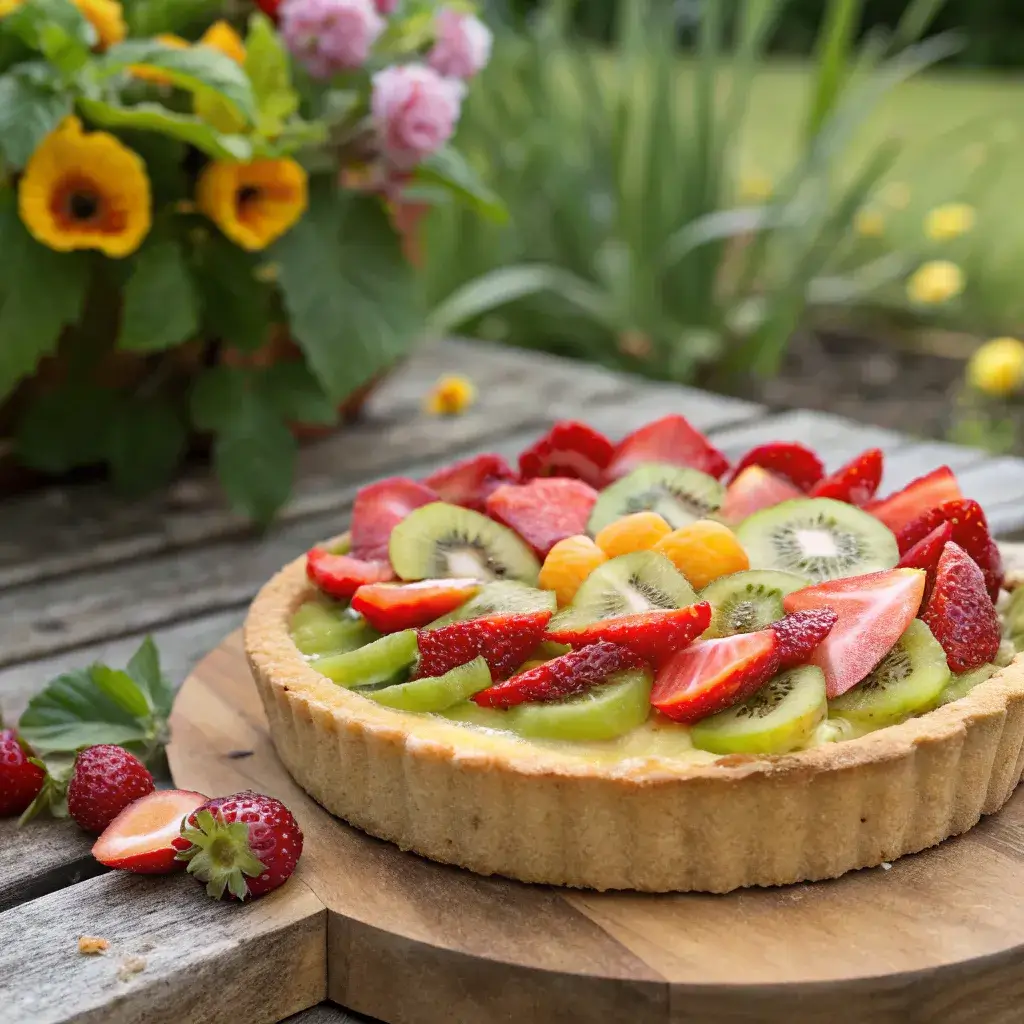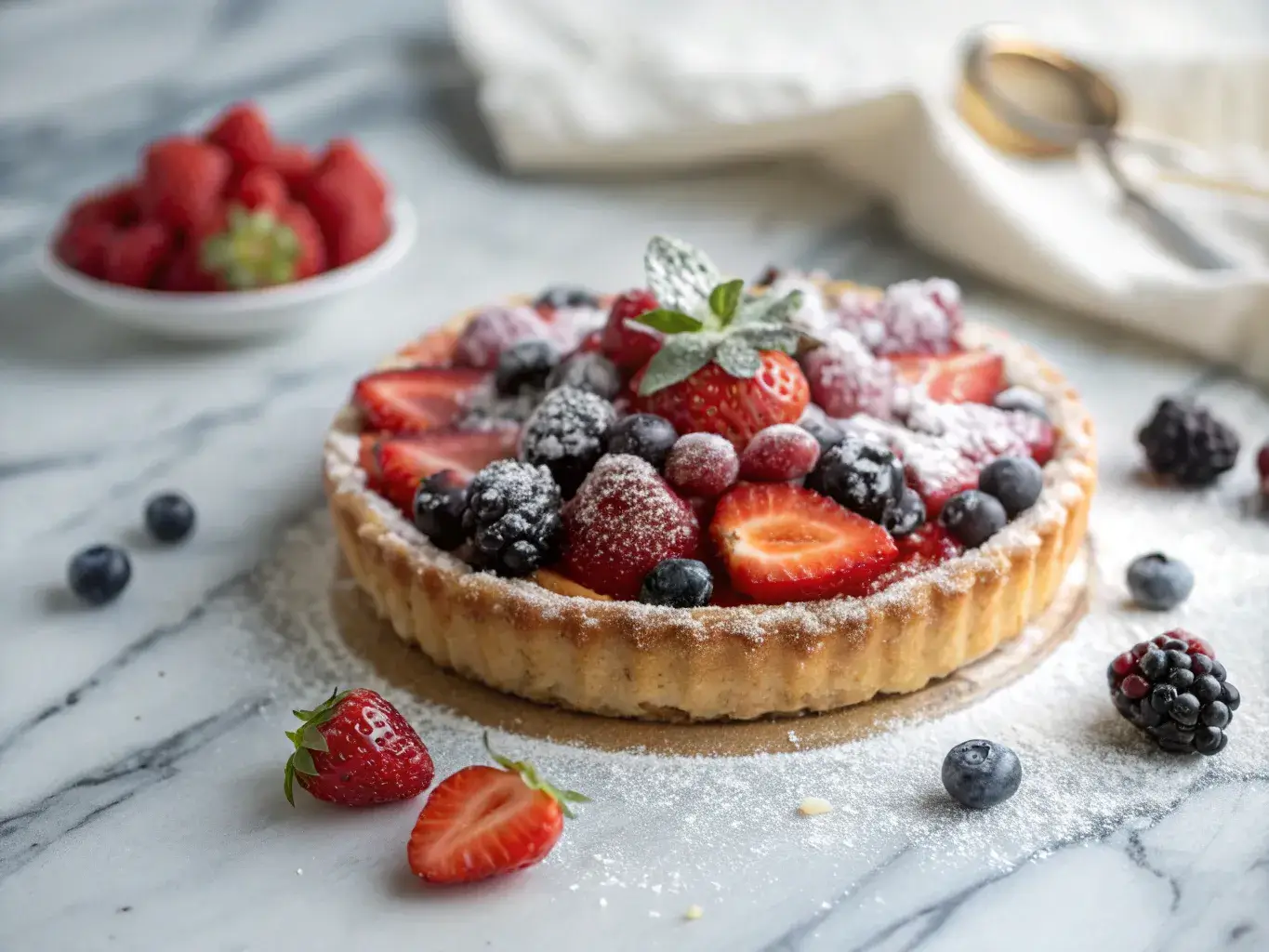Fruit pastry is more than just a sweet treat; it’s a celebration of flavor, texture, and creativity. At Recipes of Kitchen, The Gluten-Free Sweet Kitchen, I’m Lidia Bellacci, and I’ve made it my mission to reimagine traditional desserts for everyone, including those with gluten sensitivity.
After my own health journey led me to discover a gluten-free lifestyle, I refused to give up my love for flaky, fruit-filled pastries. Instead, I dove deep into perfecting gluten-free doughs and fillings that taste just as indulgent as the classics.
In this complete guide, you’ll learn how to make fruit pastries from scratch, explore different styles from around the world, understand how to choose the best fruits and creams, and even discover healthy twists. Whether you’re baking for yourself, your family, or a special occasion this guide is your step-by-step map to pastry bliss.
Understanding Fruit Pastries
What Are Fruit Pastries?
A fruit pastry is a baked dessert featuring flaky or tender pastry dough filled, topped, or layered with fruit. The fruit may be fresh, cooked, preserved, or incorporated into a jam or jelly. These pastries can take on many forms from hand pies and danishes to fruit tarts and turnovers, but what they all share is the irresistible combination of pastry and fruit.
In gluten-free baking, the goal is to recreate that same structure and flakiness using alternative flours like almond, rice, or oat. These allow for delicious results that are safe for those with gluten intolerance, like many readers of Recipes of Kitchen.
Fruit pastries are perfect for breakfast, brunch, snacks, or dessert. They can be sweetened naturally with ripe fruits or enhanced with pastry creams, icings, or crumbles.
A Brief History of Fruit-Based Pastries
The concept of enclosing fruit in dough has existed for centuries. Ancient Egyptians made honey-drenched fruit-stuffed breads. The Greeks wrapped figs in pastry, while the Romans elevated it by using wheat-based dough to encase dates and apples. But it was in medieval Europe where fruit pastries truly evolved, thanks to the growing availability of sugar and butter.
By the 17th century, French patissiers were crafting elaborate fruit tarts. In Denmark, bakers began layering dough with butter and filling it with apples, cherries, and plums, creating what we now call the Danish. In America, apple turnovers became a beloved staple, especially in the South and Midwest.
Today, fruit pastries are enjoyed across cultures, from Latin American guava pastries to Central European kolaches. And with gluten-free adaptations, more people than ever can enjoy their favorite versions.
Print
Fruit Pastry: The Ultimate Guide to Irresistible Fruit-Filled Delights
- Total Time: 33 minutes
- Yield: 4–6 pastries 1x
- Diet: Vegetarian
Description
Crispy puff pastry squares filled with a variety of fresh fruit and a sweet cream base, perfect for brunches, tea parties, or an elegant dessert.
Ingredients
- 1 sheet puff pastry, thawed
- 1/4 cup cream cheese, softened
- 2 tbsp powdered sugar
- 1/2 tsp vanilla extract
- Assorted fresh fruit (berries, kiwi, peach slices, etc.)
- 1 egg, beaten (for egg wash)
- 1 tbsp honey or fruit jam (optional, for glaze)
- Powdered sugar for dusting
- Flour for dusting
Instructions
- 1. Preheat oven to 400°F (200°C) and line a baking sheet with parchment paper.
- 2. In a small bowl, mix cream cheese, powdered sugar, and vanilla until smooth.
- 3. Lightly flour your work surface and unfold puff pastry.
- 4. Cut into 4–6 squares or circles.
- 5. Score a border about 1/2 inch from the edge of each pastry (do not cut all the way through).
- 6. Spread cream cheese mixture inside the scored area.
- 7. Top with slices of fresh fruit.
- 8. Brush edges with egg wash.
- 9. Bake for 15–18 minutes or until golden and puffed.
- 10. Let cool slightly, then brush fruit with warm honey or jam for a glossy finish.
- 11. Dust with powdered sugar before serving.
Notes
- Use firm, ripe fruit to avoid sogginess.
- Glazing the fruit adds shine and helps preserve freshness.
- Pastries are best eaten the same day but can be stored in the fridge and lightly reheated.
- Try a citrus zest in the cream cheese for a flavor boost.
- Prep Time: 15 minutes
- Cook Time: 18 minutes
- Category: Dessert
- Method: Baking
- Cuisine: French
Nutrition
- Serving Size: 1 pastry
- Calories: 200
- Sugar: 11g
- Sodium: 110mg
- Fat: 11g
- Saturated Fat: 5g
- Unsaturated Fat: 4g
- Trans Fat: 0g
- Carbohydrates: 21g
- Fiber: 1g
- Protein: 2g
- Cholesterol: 30mg
Keywords: fruit pastries, puff pastry dessert, berry tart, cream cheese pastry
Discover great ideas like the Potato Filled Pastry recipe, a savory twist that uses similar dough techniques!
Types of Fruit Pastries Around the World
Classic Danish and Its Fruit Variations
One of the most iconic forms of fruit pastry is the Danish pastry, known for its flaky, buttery layers and sweet fillings. Traditionally made with laminated yeast dough, the Danish often features fruits like cherry, raspberry, blueberry, or apple at the center. A glaze or light dusting of powdered sugar adds the final touch.
Modern versions include gluten-free dough made from a blend of rice flour and tapioca, allowing everyone to enjoy these beautiful treats. Whether it’s a braided Danish or one shaped like a pinwheel, the fruit filling adds not just sweetness, but also vibrant color and contrast in every bite.
You can make Danish-style fruit pastries at home using a quick puff pastry base and topping it with pastry cream, followed by sliced strawberries or cooked fruit compote.

Don’t miss our Strawberry Puff Pastry, which offers a simple way to enjoy this classic in gluten-free form.
Tarts, Turnovers, and Galettes
Beyond the Danish, the world of fruit pastry includes a wide array of styles that vary by region and baking method:
| Type | Description | Fruit Filling Ideas |
|---|---|---|
| Tart | A flat, open pastry with a buttery crust | Kiwi, peach, raspberry, citrus |
| Turnover | Folded pastry sealed on the edges | Apple, cherry, strawberry jam |
| Galette | Rustic French tart folded around the fruit | Mixed berries, plums, figs |
Each of these options can be made with gluten-free crusts that hold their shape while allowing the fruit to shine. Tarts often include a base layer of pastry cream or almond frangipane before adding fresh fruit. Turnovers are portable and often glazed for extra shine.
Galettes, with their imperfect edges, offer a casual yet elegant finish and are ideal for beginners exploring homemade fruit pastry options.
Ingredients That Make the Perfect Fruit Pastry
Choosing the Right Pastry Dough
At the heart of every great fruit pastry lies the dough. Whether you’re aiming for a flaky Danish, a crisp tart, or a rustic galette, the right base makes all the difference.
Classic doughs use wheat flour and butter, but in a gluten-free kitchen like mine, success comes from creative substitutions. My go-to combo for flaky gluten-free pastry includes:
- Almond flour: adds richness and moisture
- Tapioca starch: for elasticity and lightness
- Rice flour: neutral flavor and structure
- Cold butter or vegan alternative: essential for flakiness
- Chilled water or milk: helps bind without overworking
For a yeast-raised dough (like Danish), you’ll need xanthan gum or psyllium husk to help mimic gluten’s stretchy texture. Always chill your dough; this prevents shrinkage and helps lock in layers.
The perfect fruit pastry dough is tender, slightly crisp, and firm enough to hold fruit without getting soggy.
Best Fruits for Filling (Fresh vs. Preserves)
When it comes to choosing fruit, both fresh and preserved options shine, depending on your pastry style and desired texture.
| Type of Fruit | Best For | Notes |
|---|---|---|
| Fresh Berries | Tarts, Galettes, Danishes | Must be dry; excess juice softens crust |
| Apple/Pear Slices | Turnovers, Braided Pastries | Pre-cook to soften and reduce moisture |
| Jam or Jelly | Danish Centers, Thumbprint Pastries | Adds concentrated flavor and stability |
| Stone Fruits (peaches, plums) | Rustic Galettes, Pies | Slice thin, sprinkle with sugar to reduce water |
You can also roast or sauté fruits like peaches, cherries, or apples with cinnamon or lemon zest before adding them to your gluten-free dough. This enhances their natural sweetness and prevents sogginess in the crust.
Check out the Chicken and Chive Hand Pie for savory inspiration using the same pastry techniques!
Making Fruit Pastries at Home
Step-by-Step Dough Preparation
Making homemade fruit pastry isn’t just delicious, it’s empowering. Here’s a simplified step-by-step method for gluten-free pastry dough that works for danishes, tarts, and galettes:
- Whisk dry ingredients: Use 1 cup almond flour, ¾ cup rice flour, ¼ cup tapioca starch, 1 tsp sugar, ½ tsp salt
- Add butter: Use ½ cup cold butter cut into cubes. Blend into dry ingredients until crumbly
- Add cold liquid: Stir in 2–3 tbsp cold water or milk until dough forms
- Chill: Wrap dough in plastic wrap and refrigerate for 30 minutes
- Roll and shape: Lightly flour your surface with rice flour. Roll into desired thickness (¼ inch is ideal)
- Fill and bake: Top with fruit or filling, brush edges with egg wash, and bake at 375°F for 25–35 minutes until golden

Use parchment paper for easy transfer and clean-up. The goal is to avoid overworking the dough. Gluten-free flours can get dry fast.
Assembling and Baking Fruit Pastries
Whether you’re assembling a tart, a danish, or a braided pastry, a few steps will ensure perfect results:
- Brush dough with egg wash or milk to enhance golden color
- Use a spoon to layer pastry cream or jam, followed by fresh or roasted fruit
- Leave a border (½ inch to 1 inch) around the edges for folding and sealing
- Add crumbles or almond slivers on top for texture
- Chill again before baking if your kitchen is warm this prevents melting before the oven puffs the dough
Bake until the crust is golden and the fruit is bubbling slightly. Cool before glazing or dusting with powdered sugar.
Don’t miss our Top Gluten-Free Bread Brands for ideas on expanding your gluten-free baking skills.
Fruit Pastry Shaping Techniques and Styles
Fruit-Shaped Pastries: What Are They Called?
Did you know some fruit pastries are actually shaped like the fruits they’re filled with? These whimsical creations are often referred to as fruit-shaped pastries or pastry illusions. They’re made to look like peaches, apples, lemons, or even berries using specialty molds, airbrushing, or layered fruit glazes.
A popular modern trend, especially in high-end patisseries and on Instagram, these visually striking treats combine pastry art with realistic aesthetics. Inside, you’ll often find mousse, fruit compote, or jelly layered with sponge cake and encased in a glossy fruit-flavored glaze.
But in traditional baking, fruit pastry usually means the filling stars in the center, not the shape like Danish rounds or tart squares with sliced fruit toppings. Whether you opt for the real-fruit look or go classic, shaping techniques play a big role in the final experience.
Creative Folding and Topping Methods
The way you fold and top your fruit pastry can transform its texture, presentation, and even flavor distribution. Here are a few popular methods to try:
| Method | Description | Best Used For |
|---|---|---|
| Braided | Dough strips are cut and woven over the filling | Danish braids, apple strudel |
| Pinwheel | Corners of a square are cut and twisted | Mini danishes with jelly centers |
| Envelope Fold | Four corners pulled to the center | Cream cheese & jam pastries |
| Galette Fold | Rustic fold around fruit edges | Stone fruits, berries |
| Tart Shell | Pressed into a mold | Cream-filled fruit tarts |
Toppings also matter. Dust powdered sugar after baking, drizzle with icing, or brush apricot glaze for shine. Sliced almonds or a crumble topping give your fruit pastry a bakery-style finish.
Want something more savory? Check out the Potato Filled Pastry for folding inspiration using a similar dough technique.
Cream, Jelly & Fillings: Elevating Your Fruit Pastry
How to Make Pastry Cream for Fruit Fillings
A luscious pastry cream is a game-changer for any fruit pastry. This rich, smooth custard made from milk, eggs, and starch acts as a flavorful base to showcase fruit without making the pastry soggy.
Here’s a simple gluten-free version of pastry cream:
Ingredients:
- 2 cups whole milk (or dairy-free alternative)
- ¼ cup sugar
- 2 egg yolks
- 1 whole egg
- 3 tbsp cornstarch
- 1 tsp vanilla extract
- Pinch of salt
Steps:
- Heat milk until steaming (not boiling)
- In a bowl, whisk eggs, sugar, cornstarch, and salt
- Slowly pour in hot milk while whisking
- Return to stove and cook until thickened, about 3–4 minutes
- Stir in vanilla, strain, and cool
Use this cream as the first layer in tarts, danishes, or filled pastries. Pair with sliced kiwi, strawberries, or roasted peaches for that perfect fruit pastry bite.
Using Jelly or Jam in the Center of Pastries
Looking for a quicker way to add sweetness and sheen to your fruit pastry? Jelly and jam are your best friends.
They add vibrant flavor, a glossy finish, and help hold soft or juicy fruits in place. You can:
- Spoon jam into the center of a Danish before baking
- Swirl it into pastry cream for layered flavor
- Brush fruit with warmed jelly after baking to glaze
Popular choices include:
- Apricot jelly: neutral and enhances color
- Raspberry jam: tangy and bright
- Peach preserves: smooth and mellow
- Guava or fig jam: exotic and deeply sweet

If you’re making gluten-free puff or tart doughs, jelly can act as both a glue and a flavor booster. Just remember: a little goes a long way.
Check out our Strawberry Puff Pastry again for a quick look at how jelly complements the fruit layer beautifully.
Nutrition & Calories in Fruit Pastries
How Many Calories Are in a Fruit Danish Pastry?
Calories in a fruit pastry can vary greatly depending on size, ingredients, and added toppings like icing or cream. A standard fruit Danish made with puff pastry, jam, and glaze can contain anywhere from 250 to 450 calories per piece.
Here’s a quick breakdown:
| Ingredient | Estimated Calories |
|---|---|
| Puff pastry (1 sheet) | 320–360 |
| Fruit filling (2 tbsp) | 40–60 |
| Sugar glaze | 50–80 |
| Pastry cream (2 tbsp) | 60–90 |
That adds up fast. Now, in gluten-free baking, some ingredients like almond or oat flour tend to be more nutrient-dense, meaning they may carry a slightly higher calorie count, but also offer more fiber, protein, and healthy fats.
So yes, fruit pastry can be indulgent, but with thoughtful choices, you can still enjoy it as part of a balanced lifestyle.
Healthier Alternatives and Low-Sugar Versions
Looking to lighten things up? Here’s how to make your fruit pastry more nutritious without sacrificing flavor:
- Use almond or oat flour instead of refined white flours
- Sweeten with fruit puree (like mashed banana or applesauce) instead of sugar
- Bake with coconut sugar or maple syrup for lower-glycemic options
- Load up on fresh fruit like berries, peaches, or apples for fiber and antioxidants
- Swap cream for Greek yogurt in fillings or toppings
These tweaks can reduce overall sugar and boost nutrition, all while maintaining the delicious textures and flavors of a classic fruit pastry.
Brand Highlights & Pop Culture References
Post Brand Fruit-Filled Pastries
When you hear “fruit-filled pastries,” you might think of store-bought favorites like Post’s Fruity Pastry Crisps, a snack that walks the line between toaster pastry and crunchy granola bar. These prepackaged snacks are convenient and sweet, often marketed as breakfast-on-the-go.
Though tasty, they often contain additives, refined sugars, and gluten so if you’re following a gluten-free diet like mine, making your own fruit pastry at home is a far more wholesome and satisfying experience.
Fruit Pastries in Popular Media and Games (e.g., Dreamlight Valley)
Even video games are getting in on the pastry fun. In Disney Dreamlight Valley, players can craft food to restore energy, and one fan-favorite recipe is the Pastry Cream and Fruits dish. It’s a virtual version of real-life fruit pastry, made using digital equivalents of eggs, milk, fruit, and wheat.
It’s a reminder that fruit pastry isn’t just food it’s culture, creativity, and comfort, woven into everything from grocery store shelves to gaming.
Storage, Serving & Pairing Suggestions
How to Store Fruit Pastries Without Losing Crispness
Storing your fruit pastry the right way keeps it fresh and flaky for days. Here’s how:
- Let pastries cool completely before storing
- Wrap in parchment paper then place in an airtight container
- Keep at room temp for up to 2 days; refrigerate if filled with cream
- Reheat in the oven at 300°F for 5–10 minutes to restore crispness
- Avoid microwaving it makes the crusts soggy!
If freezing, do so before baking. Freeze unbaked fruit pastry on a tray, then transfer to a freezer bag. Bake from frozen, adding a few extra minutes.
Serving Ideas and Drink Pairing
A fresh-baked fruit pastry pairs perfectly with:
| Drink | Why It Works |
|---|---|
| Black coffee | Balances sweet with bitter notes |
| Herbal tea | Chamomile or mint brings light contrast |
| Sparkling water with citrus | Refreshing palate cleanser |
| Dessert wine | Ideal for formal dinners or brunches |
Serve warm, with a scoop of vanilla ice cream or whipped coconut cream. Add a sprig of mint or a drizzle of fruit reduction for gourmet appeal.
Don’t miss our Potato Filled Pastry and Macadamia Pie for more inspiration with similar techniques.
Frequently Asked Questions About Fruit Pastry
What are fruit-shaped pastries called?
Fruit-shaped pastries are often referred to as novelty pastries or marzipan fruit confections, especially when they’re crafted to look like apples, peaches, or strawberries. In French patisserie, similar designs may be called fruits déguisés. Some Asian bakeries also hand-shape pastries into charming fruit forms using molds and natural food coloring.
What are the 4 types of pastry?
The four main types of pastry are:
Puff pastry: used in danishes and turnovers
Shortcrust pastry: ideal for tarts and pies
Choux pastry: used in eclairs and cream puffs
Filo pastry: thin and crispy, great for Mediterranean desserts
Each type can be used to create variations of fruit pastry, with different textures and baking styles.
What is the Post brand fruit filled pastry?
Post’s fruit-filled product is typically called Fruity Pastry Crisps, a packaged snack that mimics traditional fruit pastry but in a crisp bar form. It’s a quick, shelf-stable option, but it may contain gluten and additives, making homemade versions a healthier choice.
How to make pastry cream and fruits in Dreamlight Valley?
In Disney Dreamlight Valley, you can craft Pastry Cream and Fruits using ingredients like:
Wheat
Milk
Sugar
Eggs
Fruit (any variety)
In real life, replicate the idea with gluten-free tart shells, homemade pastry cream, and fresh berries to bring the game to your kitchen.
How many calories in a fruit Danish pastry?
On average, a fruit Danish pastry contains 250 to 450 calories, depending on ingredients. Using gluten-free flours and natural sweeteners can slightly alter this, but portion control and ingredient swaps help keep it balanced.
A pastry with jelly or fruit in the middle?
That would typically be a Danish pastry or a thumbprint cookie, depending on size and dough type. These pastries feature a soft center filled with jam, jelly, or fresh fruit and are among the most popular forms of fruit pastry.
Conclusion: Let Fruit Pastry Bring Joy to Your Kitchen
Whether it’s the crisp bite of a galette crust, the creamy center of a Danish, or the delicate shine of fresh berries on a tart, the world of fruit pastry is a delicious invitation to create and celebrate.
At Recipes of Kitchen, we believe everyone deserves a sweet life, especially those living gluten-free. From simple ingredients to detailed folding techniques, this guide has everything you need to confidently bake fruit pastries that are just as stunning as they are satisfying.

